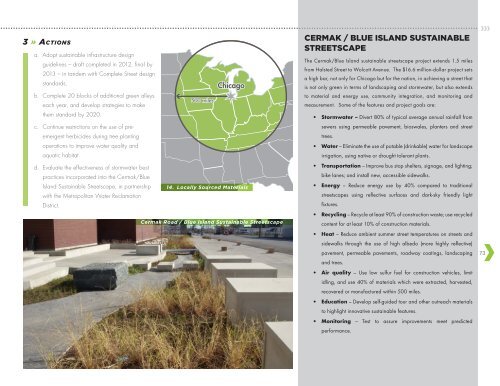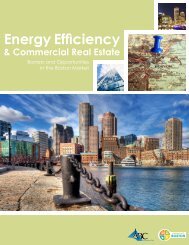Forward - City of Chicago
Forward - City of Chicago
Forward - City of Chicago
Create successful ePaper yourself
Turn your PDF publications into a flip-book with our unique Google optimized e-Paper software.
3 » Actions<br />
a. Adopt sustainable infrastructure design<br />
guidelines – draft completed in 2012, final by<br />
2013 – in tandem with Complete Street design<br />
standards.<br />
b. Complete 20 blocks <strong>of</strong> additional green alleys<br />
each year, and develop strategies to make<br />
500 miles<br />
<strong>Chicago</strong><br />
CERMAK / BLUE ISLAND SUSTAINABLE<br />
STREETSCAPE<br />
The Cermak/Blue Island sustainable streetscape project extends 1.5 miles<br />
from Halsted Street to Wolcott Avenue. The $16.6 million-dollar project sets<br />
a high bar, not only for <strong>Chicago</strong> but for the nation, in achieving a street that<br />
is not only green in terms <strong>of</strong> landscaping and stormwater, but also extends<br />
to material and energy use, community integration, and monitoring and<br />
measurement. Some <strong>of</strong> the features and project goals are:<br />
them standard by 2020.<br />
• Stormwater – Divert 80% <strong>of</strong> typical average annual rainfall from<br />
c. Continue restrictions on the use <strong>of</strong> pre-<br />
sewers using permeable pavement, bioswales, planters and street<br />
emergent herbicides during tree planting<br />
trees.<br />
operations to improve water quality and<br />
• Water – Eliminate the use <strong>of</strong> potable (drinkable) water for landscape<br />
aquatic habitat.<br />
irrigation, using native or drought tolerant plants.<br />
d. Evaluate the effectiveness <strong>of</strong> stormwater best<br />
practices incorporated into the Cermak/Blue<br />
Island Sustainable Streetscape, in partnership 14. Locally Sourced Materials<br />
with the Metropolitan Water Reclamation<br />
District.<br />
Cermak Road / Blue Island Sustainable Streetscape<br />
• Transportation – Improve bus stop shelters, signage, and lighting;<br />
bike lanes; and install new, accessible sidewalks.<br />
• Energy – Reduce energy use by 40% compared to traditional<br />
streetscapes using reflective surfaces and dark-sky friendly light<br />
fixtures.<br />
• Recycling – Recycle at least 90% <strong>of</strong> construction waste; use recycled<br />
content for at least 10% <strong>of</strong> construction materials.<br />
• Heat – Reduce ambient summer street temperatures on streets and<br />
sidewalks through the use <strong>of</strong> high albedo (more highly reflective)<br />
pavement, permeable pavements, roadway coatings, landscaping<br />
and trees.<br />
73<br />
• Air quality – Use low sulfur fuel for construction vehicles, limit<br />
idling, and use 40% <strong>of</strong> materials which were extracted, harvested,<br />
recovered or manufactured within 500 miles.<br />
• Education – Develop self-guided tour and other outreach materials<br />
to highlight innovative sustainable features.<br />
• Monitoring – Test to assure improvements meet predicted<br />
performance.




